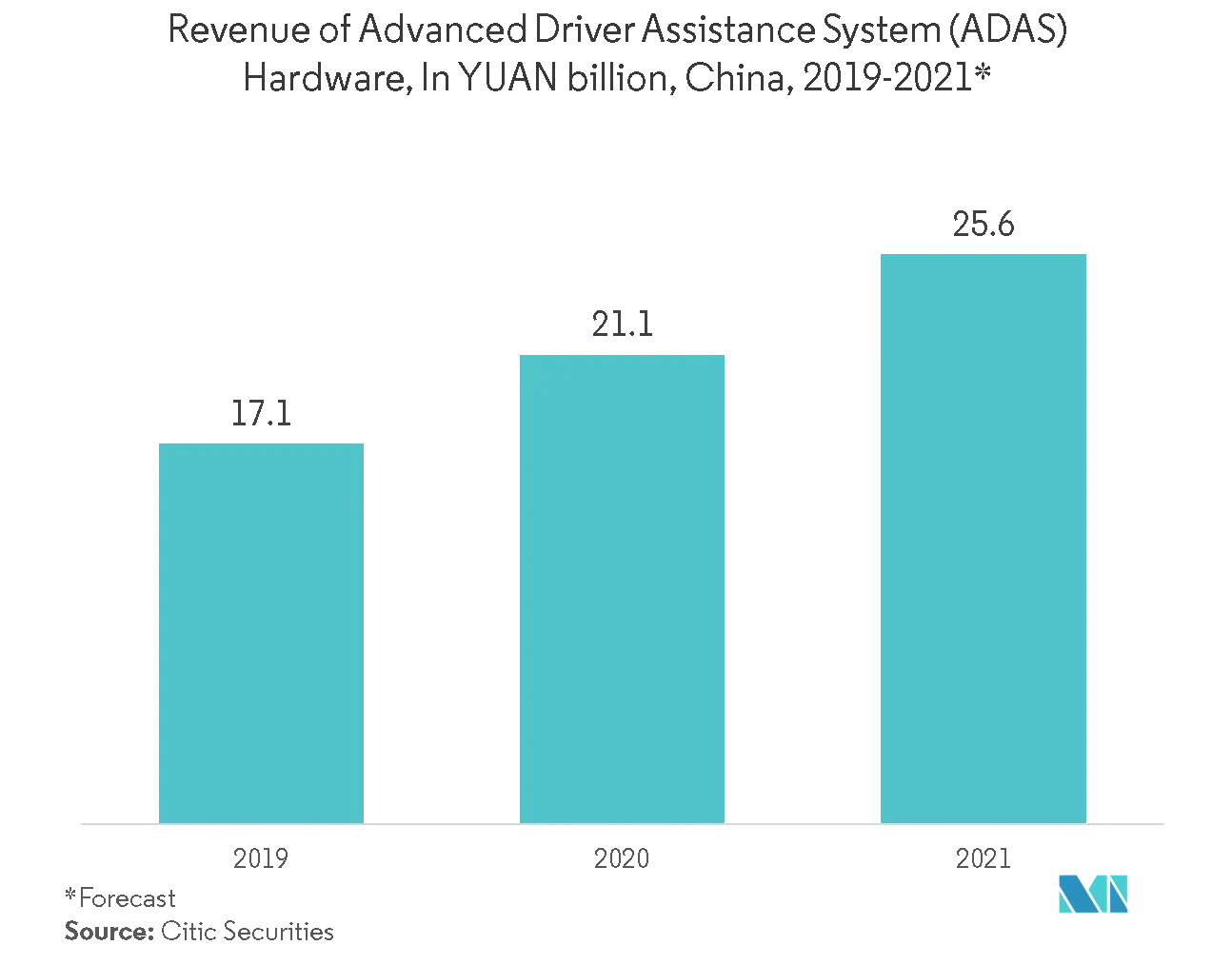Market Trends of China Automotive Microcontroller Industry
This section covers the major market trends shaping the China Automotive Microcontroller Market according to our research experts:
ADAS to Witness a Significant Growth in the Safety and Security Segment
· With increasing modernization of vehicles, the demand for microcontrollers is gaining an upsurge, particularly in applications, such as airbags and advanced driver assistance systems (ADAS) solutions. ADAS systems use electronic technology, such as microcontroller units (MCU), electronic control units (ECU), and power semiconductor devices that help the vehicle driver while driving or during parking.
· When designed with a secure human-machine interface, they are intended to increase car safety and, more generally, road safety. For safety and security, 16-bit microcontrollers are mostly being used to control the vehicle.
· Furthermore, China NCAP (C-NCAP) aims to follow the lead of Euro NCAP for its assessment protocol. The organization is currently studying the feasibility of including active safety technologies as a part of their future rating. The possibility of increased vehicle safety requirements in China is already pushing OEMs to offer more advanced ADAS. Furthermore, the China-new Car Assessment Program (C-NCAP) has added the automatic emergency braking (AEB) test with a rating score of 11%. This requirement is probably to accelerate ADAS product demand and penetration in China during the long term.
· Furthermore, STMicroelectronics announced to be named partner on an ADAS platform, to address the medium to the low-end automotive market in China, where the ADAS will be consisting of various microcontrollers that adhere to the market growth.
· Also, in April 2019, a part of the strategic collaboration, NXP invested an undisclosed sum in Hawkeye Technology (China), which will build radar sensor modules using front-end transceivers and microcontroller chips from NXP. NXP announced that the move to the more advanced systems is largely responsible for the huge growth rate in automotive radar. Whereas today’s production vehicles are typically using between one and three radar sensors for Level 1 and Level 2 ADAS, whereas future vehicles may employ as many as 6-10 radar chips on Level 4 and Level 5 vehicles
· Also, Singulato, an emerging Chinese automaker, indicates that conventional automotive design is highly different, and when it comes to intelligent driving capabilities, separate data cannot be combined for multi-scenario applications. The company has a set of sensors of its own, and another automated parking company also uses different sensors from others. Singulato further adopts integrated design at the beginning, using the same sensors to implement more than a dozen of ADAS functions. Furthermore, such design makes subsequent OTA (over-the-air) update easier. With advent adoption of integration by the company in the ADAS platform, the demand for microcontrollers is expected to increase.
· Also, players, such as Cogobuy strategically invested in Locoway in August 2019. Locoway is specialized in research and development for automatic safe driving smart terminals, including ADAS and driver monitoring systems (DMS), as well as providing hardware, software, and services for smart cars. Services by Locoway include testing and installation of ADAS and DMS for several bus companies in China. This further enhances the market demand for 16-bit microcontrollers.

Chassis to Hold a Significant Market Share
· With an increasing export value of chassis fitted with the engine on a yearly basis in China, the demand for microcontroller is expected to increase. The integration of multiple functions onto a single device emerged as a new technology trend. In the past, there were separate ECUs for separate functions. Currently, integrating them is a bigger step forward for automakers and tier 1 suppliers in China.
· In February 2019, Renesas' RH850/U2A incorporated up to four 400-MHz CPU cores, along with up to 16 megabytes of flash ROM and 3.6 MB of SRAM. It largely depends on the strength of computing power.
· In developing the new MCU (microcontroller), Renesas took elements from its existing P-line family of MCUs and then combined with elements from its existing F-line family of devices. The P-line had typically been employed in chassis.
· Furthermore, to support the ASIL D level required for chassis/safety applications, the hardware-based virtualization assist technology allows customers to implement multiple software with different functional safety levels on the RH850/U2A MCU and run concurrently without interference while maintaining the real-time performance required to control the vehicles.
· Also, in September 2019, to help the automotive industry meet the upcoming emissions regulations for single- and twin-cylinder gasoline engines, STMicroelectronics, with Arrow Electronics, released a complete reference design ECU (Electronic Control Unit) for electronic fuel injection (EFI). The SPC5-L9177A-K02 ECU reference design targets small engines for motorcycles, scooters, and three-wheelers, which must satisfy the upcoming China IV.
· The reference design key components are ST’s SPC572L Line 32-bit Power Architecture automotive-powertrain microcontroller and L9177A high-integration IC hosting power supplies, interfaces, and load actuators, which are specifically designed for the application and market needs and to manage up to four-cylinder gasoline and diesel engines in addition to chassis, transmission, steering, and braking systems.
· However, due to the COVID-19 pandemic, several Chinese vehicle assembly plants extended their seasonal shutdowns, and the automotive component supply chain is disrupted with some industrial areas in lockdown. However, with a low rate of the pandemic in China, currently, a few automotive plants reported resumption of production since March, while some are remain shuttered. Major affected carmakers in the region include Dongfeng, GM, and PSA. This hampers the export for automotive chassis integrated with the engine by which there will be significantly low growth registered by the microcontroller market, mostly for 16- and 32-bit microcontrollers.


